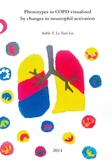Phenotypes in COPD visualized by changes in neutrophil activation

Lo Tam Loi, Adèle
- Promoter:
- Prof.dr. J.W.J. (Jan Willem) Lammers & prof.dr. L. (Leo) Koenderman
- Research group:
- Koenderman
- Date:
- September 25, 2014
- Time:
- 12:45 h
Summary
Chronic Obstructive Pulmonary Disease (COPD) is ranked number 3 by the WHO list of important diseases worldwide and is the only major disease with increasing mortality. 15-20% of the smokers will develop COPD. The pathogenesis of this (cigarette) smoke induced COPD is still unclear. It is becoming clear that the inflammatory response in COPD is not only present in the lungs but is also found systemically. This systemic inflammation has important consequences for the clinical presentation of COPD, because this systemic response contributes to extra-pulmonary manifestations in COPD. Therefore, COPD is a heterogeneous disease with a complex interaction between genetic background, environmental factors and behaviour. Currently lung function (FEV1 and FEV1/FVC) is still the standard for the diagnosis and classification of COPD. However, this classification of COPD does not allow the characterization of systemic inflammation in COPD. Neutrophils are part of the innate immunity and play an important role in the pathogenesis of COPD. COPD patients have increased numbers of neutrophils in their sputum, bronchoalveolar lavage (BAL) fluid, bronchial tissue and peripheral blood. These neutrophils can secrete proteases, cytokines, chemokines and other inflammatory mediators that contribute to the inflammation in the lungs and the extra-pulmonary compartment. This thesis is focused on the pathogenesis of systemic inflammation in COPD using alternative approaches by characterizing different inflammatory phenotypes of neutrophils as read-out for the innate immune response in all stages of COPD from preclinical to advanced disease. These studies showed that subtle changes in the functionality of peripheral neutrophils can help to identify different COPD phenotypes.